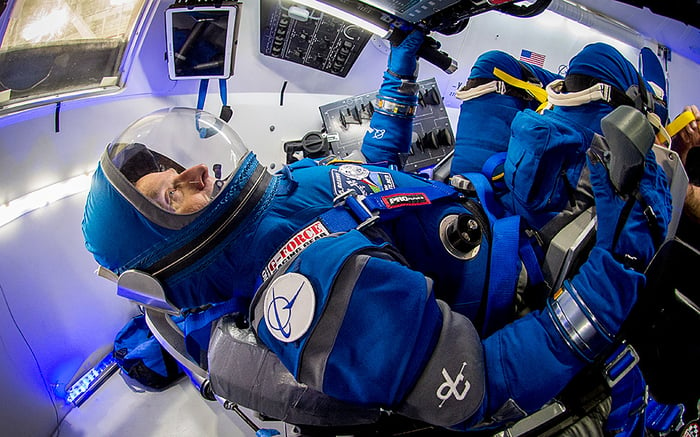In his first earnings conference call representing Boeing last week, new Boeing (BA -0.76%) CEO Dave Calhoun highlighted a series of challenges facing the aerospace behemoth.
"The 737 MAX is critically important to us," he said, in a nod to the obvious. Boeing also has work to do getting its 777X and the 737 MAX 10 aircraft ready for the market, growing its new Boeing Global Services business, and finalizing the details of its Embraer partnership.
Today though, I want to talk about none of these things. Today, I want to talk about the Boeing Starliner spacecraft.

Something was missing from last year's uncrewed Starliner mission -- a crew to fix Starliner's problems when they happened. Image source: Boeing.
Starliner costs Boeing a line item
As Calhoun averred, Boeing is already "preparing for the first Starliner crewed mission." Unfortunately, before it does that, Boeing might be required to re-do its first uncrewed mission.
Boeing's "uncrewed Orbital Flight Test of the CST-100 Starliner ... was abbreviated due to anomalies experienced during the mission preventing the docking with the International Space Station (ISS)," Calhoun said during the call. Now, "NASA is in the process of reviewing the data from our December 2019 mission" and will have to decide whether its failed attempt to dock to the space station -- which was part of the company's contract with NASA -- means that Boeing must redo its test flight to prove that Starliner can dock with ISS without a crew aboard.
NASA has not yet made this decision. However, recognizing its unfulfilled contractual obligation, and the potential that NASA may require it to rerun its test flight and fulfill said obligation, Calhoun says Boeing is taking a "$410 million pre-tax charge to provision for the additional uncrewed mission for the Commercial Crew program as well as several performance items."
What it means for investors
Calhoun noted that Boeing's charge to earnings shaved half a percentage point off of the operating profit margin of its Boeing Defense, Space & Security (BDS) division in the fourth quarter. That may not sound like much, but consider:
According to data from S&P Global Market Intelligence, BDS's operating profit margin last quarter was a bare 0.5%. If Starliner subtracted 0.5%, Boeing's bungled Starliner mission actually cost the division half of its profits in the quarter. While not the only factor contributing to Boeing's $2.5 billion quarterly operating loss, Starliner was a major contributor to Boeing booking its second money-losing quarter out of the past three.
The good news is that what generally accepted accounting principles (GAAP) take, they may also give back. In theory at least, NASA could waive Boeing's ISS-docking obligation and permit Boeing to proceed directly to a crewed test flight this year -- and for two good reasons.
First, self interest. NASA has a vested interest in getting two (or more) contractors approved to run crewed taxi missions to ISS and back because the more bidders there are for these contracts, the more they're likely to drive each others' prices down through competition, lowering NASA's cost of operating the space station. The sooner Boeing gets its Starliner approved for ISS missions, the sooner NASA can begin leveraging market economics to keep its prices low.
Second, logic. As Boeing, NASA, and the NASA astronauts who plan to eventually fly aboard Starliner made clear in their press conference immediately following the December Starliner debacle, the fact that there was no crew aboard Starliner may have actually made the spaceship's performance worse than if there had been a crew on board. "Had we been on board there could have been actions that we could have taken [to right the ship]," said NASA astronaut Nicole Mann. "That's our job. That's what we're trained to do."
If this is the case, it follows logically that NASA can best fix the problem that doomed the last Starliner mission by putting aboard the next Starliner mission the crucial element needed to deal with unforeseen technical glitches: human problem-solvers who can fix problems as they arise.
If doing so saves NASA -- and Boeing -- money in the process, then that's all to the better.





